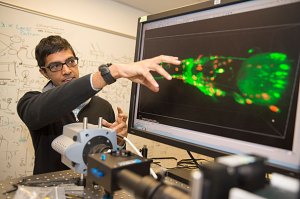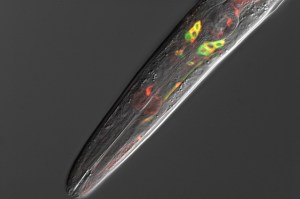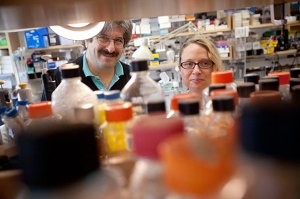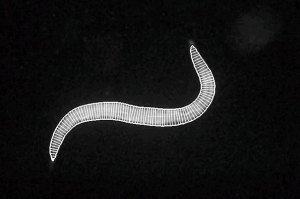Tag: C. elegans
-
Science & Tech
How does infection change social behavior?
A new study illuminates the way pathogens — and pheromones — alter social behavior in animals.

-
Science & Tech
Forgetting, fast and slow
Forgetting generates changes in the brain and does not reverse the learning process, Harvard study finds.

-
Health
Watching sensory information translate into behavior
A state-of-the-art microscope built by Harvard researchers will allow scientists to capture 3-D images of all the neural activity in the brains of tiny, transparent C. elegans worms as they crawl.

-
Health
Perception of food consumption overrides reality
Targeting mechanisms in the central nervous system might yield the beneficial effects of low-calorie diets on healthy aging without the need to alter food intake, suggests new research from Harvard T.H. Chan School of Public Health.

-
Health
Neurons at work
Using genetic tools to implant genes that produce fluorescent proteins in the DNA of transparent C. elegans worms, Harvard scientists have been able to shed light on neuron-specific “alternative splicing,” a process that allows a single gene to produce many different proteins.

-
Health
Linking insulin to learning
Work led by Yun Zhang, associate professor of organismic and evolutionary biology, shows how the pathway of insulin and insulinlike peptides plays a critical role in helping to regulate learning and memory.

-
Health
Sophisticated worms
In a new study of worm locomotion, researchers show that a single type of motor neuron drives an entire sensorimotor loop.

-
Health
Controlling behavior, remotely
Researchers have been able to take control of tiny, transparent worms by manipulating neurons in their brains, using precisely targeted pulses of laser light.

-
Health
Life lessons from an old worm
Research is uncovering the genetic roots of aging, peeling back the once common understanding that creatures simply “wore out” as they aged, and slowly revealing the mechanisms that control a process determined by our genes and that proceeds at different speeds for different species.

-
Health
Following the worm
Harvard research examining the nervous system of Caenorhabditis elegans — tiny, transparent worms — suggest a path for investigations that may shed light on disorders such as schizophrenia.

-
Health
What makes a worm say ‘yuck’
Researchers at Harvard-affiliated Massachusetts General Hospital have uncovered a new way that animals detect pathogens, by detecting disruptions of critical cellular processes.

-
Health
Making the worms turn
Biophysicist Aravinthan Samuel has developed new techniques to monitor and influence the behavior of roundworms to learn how their basic nervous systems work, a first step to understanding the circuitry in more complex creatures, like humans.

-
Health
‘Circuits of sense and sensibility’
A Harvard biologist succeeds in mapping a neural network for learned olfactory behavior, using a roundworm model to trace the dislike of a particular smell to the reaction that avoids it.

-
Science & Tech
Light touch
Physicists and bioengineers have developed an optical instrument allowing them to control the behavior of a worm just by shining a tightly focused beam of light at individual neurons inside the organism.




